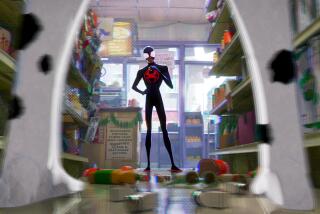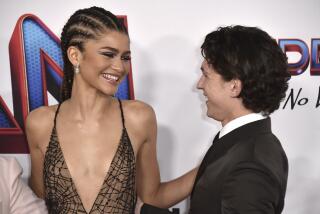The Spider and the Fly Girl
“Spider-Man” may look like an action comic come to life, but its best feature is its romance comic heart. It’s that rare cartoon movie in which the villain is less involving than the love story.
Like any celebrity biography, “Spider-Man” is more interesting when its subject is struggling than after he succeeds--and of Spider-Man’s renown there can be no doubt. Uncommonly popular since his comic-book creation by Stan Lee and Steve Ditko some 40 years ago, Spidey was conceived as a new kind of hero, very much a teenager with age-specific uncertainties and anxieties that having unusual powers did nothing to ease. But let Peter Parker, Spider-Man’s alter ego, tell you himself in the voice-over that starts the film:
“Who am I? You sure you wanna know? The story of my life is not for the faint of heart. If somebody said it was a happy little tale, if somebody told you I was just your average, ordinary guy, not a care in the world ... somebody lied.”
Director Sam Raimi, a long-time “Spider-Man” fan, was once known for mainlining the kind of murky midnight sensibility that Tim Burton brought to the “Batman” films. Though he’s used Burton’s composer Danny Elfman, Raimi’s tone here is distinctly sunny. And though his “Spider-Man” marks time more than it needs to and is no more than sporadically exhilarating, it does enough things right to be a solid comic-book citizen.
The key thing Raimi did right was insist on Tobey Maguire (“Wonder Boys,” “The Cider House Rules”) for the title character. Though he convincingly trained and bulked up for the role, Maguire will never be the traditional hunk that studios prefer in these kinds of parts. But the appropriateness of his creaky-voiced sincerity, the very ordinariness of his offbeat charisma, turns him into the most convincing of Spider-Men.
Before there was a Spider-Man, there was Peter Parker, a senior at Midtown High School in Queens, N.Y., who’s so nerdy even the school bus driver wants nothing to do with him. An orphan who lives with his Aunt May (Rosemary Harris) and Uncle Ben (Cliff Robertson), Peter has pined for the lovely girl next door, Mary Jane Watson (a red-headed Kirsten Dunst) ever since he was 6. A lot of good that’s done him.
Peter has only one friend and fellow outcast, Harry Osborn (James Franco of TV’s “James Dean”), the son of the fabulously wealthy Norman Osborn (Willem Dafoe), a man whose expertise in nanotechnology has made his company, Oscorp, a key supplier of advanced weapons to the Pentagon.
One fateful day, Peter accompanies his class on a field trip to the science departments of Columbia University. As photographer for the school paper, Peter is concentrating on a shot of Mary Jane when a rare, genetically designed super-spider takes a healthy bite out of him.
By the next morning, Peter is a different person. His body is buff, he doesn’t need his glasses, and he has reflexes ordinary humans can’t even imagine. Uncle Ben thinks it’s just raging hormones, but we know better. We know that Spider-Man has been born.
If these intentionally dopey interactions with Aunt May and Uncle Ben are the film’s weakest links, its strengths are the sequences in which Peter discovers and then shakily/gleefully tries out his spider powers. Scenes of him climbing walls, slinging webs and then gradually, through awkward trial and error, learning how to use them are cleverly worked out and great fun to experience. It’s also enjoyable to watch how the film, through a combination of acrobatic stand-ins and computer-generated imagery, enables Spider-Man to hurtle and swoop through the concrete caverns of Manhattan as if he were Tarzan on the most elastic of jungle vines.
What “Spider-Man” hasn’t been able to manage is a creditable villain. Green Goblin, the bad guy, is in reality that fabulously wealthy scientist Norman Osborn, who tested performance-enhancement drugs on himself and found out--too late!--that the potential risks of violent behavior and insanity were all too real.
Screenwriter David Koepp, who does a creditable job laying out Spidey’s origins, has less to offer once our hero accepts that “with great power comes great responsibility” and starts to fight crime. Green Goblin is a completely generic evil-doer, and the uninventive battles with him are not helped by dialogue like “Goblin, what have you done!”
What we do root for in “Spider-Man” is the romance between Mary Jane and Peter. Dunst and Maguire make a real connection on screen, and we are involved in their relationship to an extent that’s rare in films like this.
Paradoxically, this makes Parker’s Clark Kent-ish unwillingness to tell MJ his secret identity less palatable than it would otherwise be. But with a sequel already in the works, mere human desires aren’t allowed to get in the way of the almighty dollar.
MPAA rating: PG-13, for stylized violence and action. Times guidelines: a few intense dreamlike sequences but otherwise fairly mild.
‘Spider-Man’
Tobey Maguire...Spider-Man/Peter Parker
Willem Dafoe...Green Goblin/
Norman Osborn
Kirsten Dunst...Mary Jane Watson
James Franco...Harry Osborn
Cliff Robertson...Ben Parker
Rosemary Harris...May Parker
A Marvel Enterprises/Laura Ziskin production, released by Columbia Pictures. Director Sam Raimi. Producers Laura Ziskin, Ian Bryce. Executive producers Avi Arad, Stan Lee. Screenplay David Koepp, based on the Marvel Comic Book by Stan Lee and Steve Ditko. Cinematographer Don Burgess. Editors Bob Murawski, Arthur Coburn. Costumes James Acheson. Music Danny Elfman. Production design Neil Spisak. Art directors Tony Fanning, Stella Vaccaro. Set decorator Karen O’Hara. Running time: 2 hours, 1 minute.
In general release.
More to Read
Only good movies
Get the Indie Focus newsletter, Mark Olsen's weekly guide to the world of cinema.
You may occasionally receive promotional content from the Los Angeles Times.










